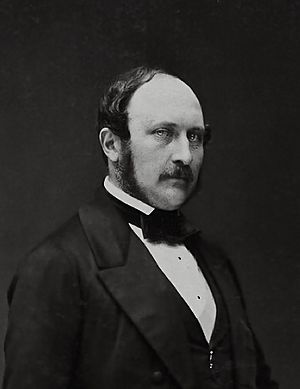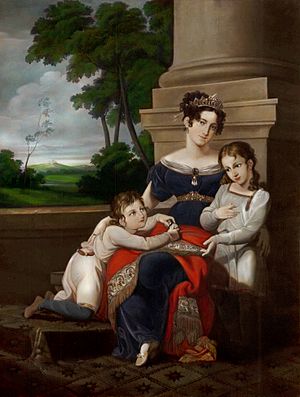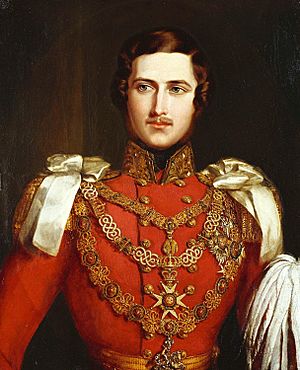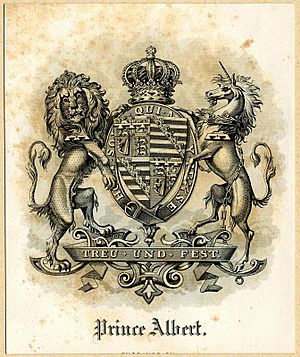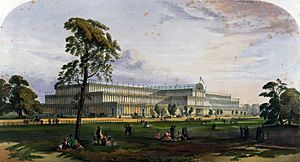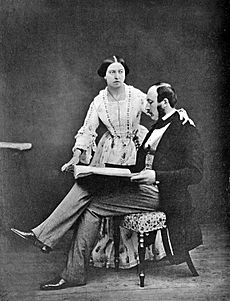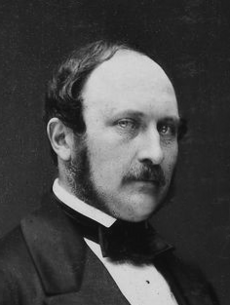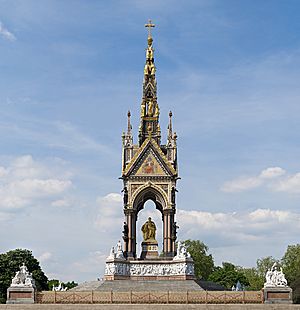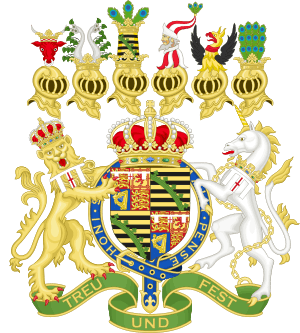Albert, Prince Consort facts for kids
Prince Albert of Saxe-Coburg and Gotha (born Francis Albert Augustus Charles Emmanuel) was the husband of Queen Victoria. He was her consort from their marriage in 1840 until his death in 1861.
Albert was born in a German duchy called Saxe-Coburg-Saalfeld. His family was related to many royal families in Europe. He married his first cousin, Victoria, when he was twenty years old. They had nine children together. At first, Albert felt his role as consort did not give him much power. But he soon became known for supporting important causes. These included educational reform and ending slavery around the world. He also managed the Queen's household and estates. He played a huge part in organizing the Great Exhibition of 1851, which was a big success.
Victoria relied more and more on Albert's advice. He helped Britain's constitutional monarchy grow. He encouraged Victoria to be fair in her dealings with Parliament. Albert died in 1861 at the age of 42. Victoria was so sad that she wore black for the rest of her life. Their eldest son became Edward VII after her death in 1901. He was the first British monarch from the House of Saxe-Coburg and Gotha, named after Albert's family.
Contents
Early Life of Prince Albert
Albert was born at Schloss Rosenau, near Coburg, Germany. He was the second son of Ernest III, Duke of Saxe-Coburg-Saalfeld. His mother was Louise of Saxe-Gotha-Altenburg. His future wife, Victoria, was born in the same year.
Albert was baptized into the Lutheran Evangelical Church. This happened on 19 September 1819. In 1825, his great-uncle died. This led to changes in the German duchies. Albert's father became the first Duke of Saxe-Coburg and Gotha.
Albert and his older brother, Ernest, grew up together. Their parents' marriage was difficult and they later divorced. Their mother left the court in 1824. She died in 1831. The brothers were taught at home. Later, they studied in Brussels. Albert also went to the University of Bonn. There, he studied law, economics, philosophy, and art history. He was good at music and sports like fencing and riding.
Albert's Marriage to Queen Victoria
By 1836, the idea of Albert marrying his cousin Victoria came up. Their uncle Leopold, King of the Belgians, suggested it. At this time, Victoria was next in line to become the British Queen. Her father had died when she was a baby. Her elderly uncle, King William IV, had no children.
Victoria's mother was the sister of Albert's father and King Leopold. Leopold arranged for Albert and his brother to visit Victoria in May 1836. Victoria thought Albert was very handsome. She wrote, "He possesses every quality that could be desired to render me perfectly happy."
Victoria became Queen at age eighteen on 20 June 1837. She was interested in Albert's education for his future role. But she did not want to rush into marriage. Albert visited Italy in 1838–39.
Albert returned to the United Kingdom in October 1839. He came to visit the Queen and settle the marriage. Albert and Victoria liked each other very much. The Queen proposed to him on 15 October 1839. They married on 10 February 1840 at the Chapel Royal, St James's Palace. Before the wedding, Albert became a British citizen. He was given the title Royal Highness.
At first, many British people did not like Albert. They saw him as coming from a small, less important German state. The British Prime Minister, Lord Melbourne, advised against making Albert "King Consort". Parliament also did not want Albert to become a peer. This was partly due to anti-German feelings. They wanted to keep Albert out of politics.
Parliament gave Albert less money than previous consorts. He received £30,000 instead of £50,000 a year. Albert said he did not need a British peerage. He felt being a Duke of Saxony was a higher title. For seventeen years, Albert was known as "HRH Prince Albert". On 25 June 1857, Victoria officially gave him the title Prince Consort.
Prince Consort's Role
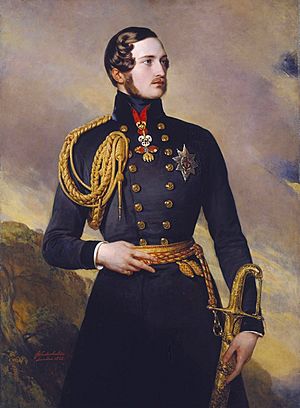
Albert's new position as the Queen's husband was important but also difficult. Albert himself said, "I am only the husband, not the master in the house." The Queen's household was run by her former governess, Baroness Lehzen. Albert worked to remove her from this role.
Within two months of their marriage, Victoria was pregnant. Albert began to take on public duties. He became President of the Society for the Extinction of Slavery. He also helped Victoria with her government papers. In June 1840, someone shot at Albert and the pregnant Victoria. They were not hurt. Newspapers praised Albert for his bravery.
Albert gained public support and political influence. In August, Parliament passed a law. It named him regent if Victoria died before their child was old enough to rule. Their first child, Victoria, was born in November. Eight more children followed over the next seventeen years. All nine children lived to adulthood. This was partly due to Albert's focus on a healthy upbringing. By 1842, Albert had successfully removed Lehzen from the nursery. She left Britain permanently, which made Albert very happy.
After the 1841 election, Sir Robert Peel became Prime Minister. He made Albert chairman of a Royal Commission. This group was in charge of decorating the new Palace of Westminster. The old Palace had burned down. Albert wanted to promote fine arts in Britain. Albert was more successful as a private art collector. He bought old German and Italian paintings. He also bought works from artists like Franz Xaver Winterhalter and Edwin Landseer.
Albert and Victoria were shot at again in May 1842. They were unharmed. The person responsible was arrested. At first, some people found the royal couple too formal in public. But in private, they were more relaxed. In 1844, Albert returned to Coburg when his father died. This was the first time he and Victoria were apart since their marriage.
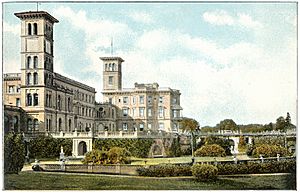
By 1844, Albert had improved the royal finances. He saved enough money to buy Osborne House on the Isle of Wight. This was a private home for their growing family. Over the next few years, a new house was built there. Albert designed it with Thomas Cubitt. Albert also improved the royal estates. His farm at Windsor was admired. Under his care, the income from the Duchy of Cornwall (the Prince of Wales's property) increased.
Albert supported raising the working age for children. He also supported free trade. In 1846, Albert attended a debate in the House of Commons. He showed support for Prime Minister Peel. During Peel's time as Prime Minister, Albert's influence grew. He saw all the Queen's papers. He wrote her letters and was present when she met her ministers. A royal official wrote that Albert "is King to all intents and purposes."
Albert's Reforms and Innovations
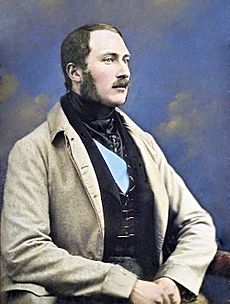
In 1847, Albert was chosen as Chancellor of the University of Cambridge. He worked to make university studies more modern. He expanded subjects beyond math and classics. He added modern history and natural sciences.
In 1848, revolutions spread across Europe. This was due to economic problems. There were some protests in England, but no revolution. Albert gained public praise for his caring views. He spoke about helping working-class people. He said it was the "duty of those who... enjoy station, wealth, and education" to help others.
Albert had modern and liberal ideas. He led reforms in education, welfare, and royal finances. He also had a special interest in using science and art in manufacturing. The Great Exhibition of 1851 was largely thanks to his efforts. Albert was president of the Royal Commission for the Exhibition. He had to fight for every step of the project. Some people worried that foreign visitors would cause trouble. Albert thought this was silly. He believed British manufacturing would benefit from seeing products from other countries.
The Queen opened the exhibition on 1 May 1851. It was held in a special glass building called the Crystal Palace. The exhibition was a huge success. The money earned, £180,000, was used to buy land in South Kensington. This land was used to build educational and cultural places. These included the Natural History Museum, Science Museum, and what would become the Royal Albert Hall and the Victoria and Albert Museum. People sometimes called this area "Albertopolis".
Family Life and Public Duties (1852–1859)
In 1852, Albert used an unexpected gift of money to buy Balmoral Castle. He started a big project to improve it. That same year, he took on several roles after the death of the Duke of Wellington. Albert wanted to modernize the army, which was much needed.
Albert believed the military was not ready for war. He thought a diplomatic solution was better than fighting. But the London press showed a different view. Albert's popularity went down.
By March 1854, Britain and Russia were fighting in the Crimean War. Albert created a plan to win the war. He suggested surrounding Sevastopol and weakening Russia's economy. This became the plan for the Allied forces. Early hopes in Britain faded. The press reported that British troops were not well-equipped. They were also managed by old generals using old tactics.
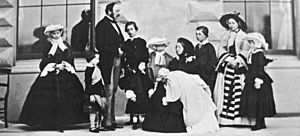
Left to right: Alice, Arthur, Albert (Prince Consort), Albert Edward (Prince of Wales), Leopold, Louise, Queen Victoria with Beatrice, Alfred, Victoria and Helena
Albert supported many public education groups. He often spoke about the need for better schooling. A collection of his speeches was published in 1857. He was seen as a supporter of education and new technology. He was invited to speak at science meetings. For example, he spoke at the British Association for the Advancement of Science in 1859.
Albert continued to focus on his family's education. He also managed the royal household. His children's governess thought he was very kind and patient. She said he joined in family games with excitement. He felt sad when his oldest daughter left for Prussia to get married in 1858. He was also disappointed that his oldest son, the Prince of Wales, did not do well with his strict education plan. Albert's biographers say the family relationships were "friendly, affectionate and normal."
Illness and Death
Albert was very sick with stomach cramps in August 1859. In autumn 1860, he was driving a carriage when the horses bolted. Albert jumped out to save himself. He told his brother and oldest daughter that he felt his time was coming.
In March 1861, Victoria's mother died. Victoria was very sad. Albert took on most of the Queen's duties, even though he was ill. The last public event he attended was the opening of the Royal Horticultural Gardens in June 1861. In August, Victoria and Albert visited the Curragh Camp in Ireland. Their son, the Prince of Wales, was doing army service there.
By November, Victoria and Albert were back at Windsor. The Prince of Wales was at Cambridge University. Two of Albert's cousins died from typhoid fever. In his last weeks, Albert had pains in his back and legs.
The Trent Affair happened when American forces took Confederate envoys from a British ship. This almost caused a war between the United States and Britain. Albert was very ill, but he helped to calm Britain's response. On 9 December, one of Albert's doctors said he had typhoid fever. Albert died at 10:50 p.m. on 14 December 1861. He passed away in the Blue Room at Windsor Castle. The Queen and five of their children were with him. Doctors at the time said he died of typhoid fever. But some modern writers think he might have had a long-term illness. This could have been Crohn's disease, kidney failure, or abdominal cancer.
Albert's Legacy
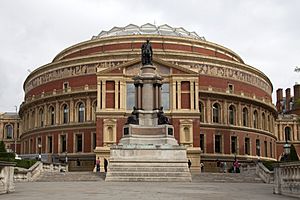
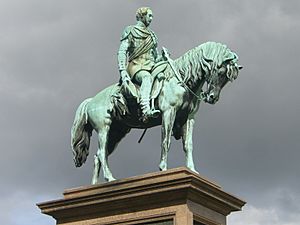
The Queen was overcome with sadness. The public, who had not always liked Albert, now felt sympathy for him. Victoria wore black for the rest of her life to show her mourning. Albert's rooms in all his houses were kept exactly as they were. This included bringing hot water in the morning and changing linens daily. This was common for very rich families. Victoria withdrew from public life. This undid some of Albert's work to make the monarchy a national symbol.
Albert is known for bringing in the idea that the British royal family should stay out of politics. Before he married Victoria, she supported the Whigs. For example, early in her reign, Victoria stopped a Tory government from forming. She refused to let Sir Robert Peel change her ladies-in-waiting.
Albert's body was first buried in St George's Chapel, Windsor Castle. A year later, his remains were moved to Frogmore Mausoleum. This building was not finished until 1871. The stone coffin for him and the Queen was made from the largest piece of granite ever found in Britain. Albert had asked for no statues of him. But many public monuments were built across the country and the British Empire. The most famous are the Royal Albert Hall and the Albert Memorial in London.
Many places and things are named after Albert. These include Lake Albert in Africa and the city of Prince Albert, Saskatchewan. The Albert Medal is also named after him. Four British Army regiments were named after him. He and Queen Victoria were very interested in developing Aldershot as a military town. They had a wooden Royal Pavilion built there. They often stayed there for army reviews. Albert also started the Prince Consort's Library at Aldershot, which is still there today.
Books written about Albert after his death often praised him highly. Queen Victoria approved and watched over a five-volume book about him. Later books were more critical. But they were partly proven wrong by biographers who had access to Victoria's journals. Some popular stories about Prince Albert are not true. For example, he did not introduce Christmas trees to Britain. Newer books show Albert as a tragic romantic figure. He died too young, and Victoria mourned him for her whole life. In the 2009 movie The Young Victoria, Albert is shown as a hero. In the movie, he is shot during an attack, but this did not happen in real life.
Titles and Honours
Titles and Styles
- 26 August 1819 – 12 November 1826: His Serene Highness Prince Albert of Saxe-Coburg-Saalfeld, Duke of Saxony
- 12 November 1826 – 6 February 1840: His Serene Highness Prince Albert of Saxe-Coburg and Gotha, Duke of Saxony
- 6 February 1840 – 25 June 1857: His Royal Highness Prince Albert of Saxe-Coburg and Gotha, Duke of Saxony
- 25 June 1857 – 14 December 1861: His Royal Highness The Prince Consort
Honours
British
- KG: Knight of the Garter, 16 December 1839
- KT: Knight of the Thistle
- KP: Knight of St Patrick
- GCB: Order of the Bath
- Knight Grand Cross, 6 March 1840
- Great Master, 25 May 1847
- KSI: Extra Knight of the Star of India, 25 June 1861
- GCMG: Knight Grand Cross of St Michael and St George
Foreign
 Knight of the Golden Fleece, 27 April 1841
Knight of the Golden Fleece, 27 April 1841 Knight of the Elephant, 10 January 1843
Knight of the Elephant, 10 January 1843 Knight of the Seraphim, February 1856
Knight of the Seraphim, February 1856
Arms
When he married Queen Victoria in 1840, Prince Albert received his own grant of arms. These arms combined the royal coat of arms of the United Kingdom with his family's arms of Saxony. His personal motto was the German Treu und Fest, meaning "Loyal and Sure".
Albert and Victoria's Children
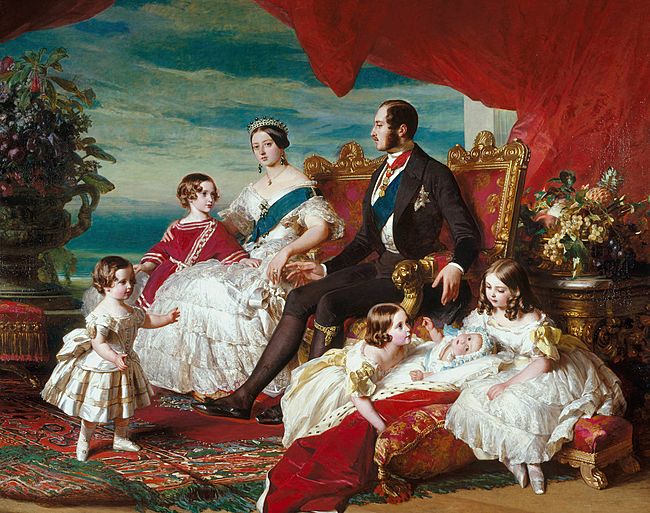
| Name | Birth | Death | Notes |
|---|---|---|---|
| Victoria, Princess Royal later German Empress and Queen of Prussia | 21 November 1840 | 5 August 1901 | married 1858, Crown Prince Frederick, later Frederick III, German Emperor; had issue |
| Prince Albert Edward, Prince of Wales, later Edward VII | 9 November 1841 | 6 May 1910 | married 1863, Princess Alexandra of Denmark; had issue |
| Princess Alice, later Grand Duchess of Hesse and by Rhine | 25 April 1843 | 14 December 1878 | married 1862, Prince Louis, later Ludwig IV, Grand Duke of Hesse and by Rhine; had issue |
| Prince Alfred, Duke of Edinburgh, later Duke of Saxe-Coburg and Gotha | 6 August 1844 | 30 July 1900 | married 1874, Grand Duchess Marie Alexandrovna of Russia; had issue |
| Princess Helena | 25 May 1846 | 9 June 1923 | married 1866, Prince Christian of Schleswig-Holstein; had issue |
| Princess Louise | 18 March 1848 | 3 December 1939 | married 1871, John Campbell, Marquess of Lorne, later 9th Duke of Argyll; no issue |
| Prince Arthur, Duke of Connaught and Strathearn | 1 May 1850 | 16 January 1942 | married 1879, Princess Louise Margaret of Prussia; had issue |
| Prince Leopold, Duke of Albany | 7 April 1853 | 28 March 1884 | married 1882, Princess Helena of Waldeck and Pyrmont; had issue |
| Princess Beatrice | 14 April 1857 | 26 October 1944 | married 1885, Prince Henry of Battenberg; had issue |
Prince Albert had 42 grandchildren. Four of them became ruling monarchs. These included King George V of the United Kingdom and Wilhelm II, German Emperor. Five of his grandchildren married monarchs. Albert's many descendants include royal and noble families all over Europe.
Images for kids
-
Portrait by Winterhalter, 1859
See also
 In Spanish: Alberto de Sajonia-Coburgo-Gotha para niños
In Spanish: Alberto de Sajonia-Coburgo-Gotha para niños


